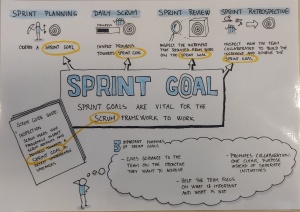Sprint goals proves to be a vital element of Scrum, but it is often overlooked and neglected because it is difficult. This blog post will describe one way to kick-start the use of sprint goals in a team or ScrumMaster CoP. Before I describe the approach I would like to explain the background, that lead me there.
Background
I was blinded by my own approach and I was just executing Scrum in a Zombie like way. In my eagerness of facilitating the events “right” I have forgotten why we were doing this in the first place. I was fallen into the trap, but the content of Barry Overeem and Christiaan Verwisj from The Liberators came to the rescue.
One of the two driving principles as described in their article about the Scrum Framework made me realize that using and working with sprint goals, was something I have neglected, even though I know it is important. Then I listened to the the podcast Scrum Mythbusters: Having A Sprint Goal Is Optional In Scrum. It changed a lot for me. The podcast highlighted many of the challenges I faced together with my teams, and I felt that every sentence was an important point that could help the team. This was too much information for me to remember, and I didn’t want to miss a thing, so I decided to do a graphical recording of the Podcast.
It resulted in 4 posters.
With these 4 posters in hand, and a topic to important to be forgotten, I had to find a way on how to share this and enable others to reflect upon and start working with spring goals. I ended up with the structure below, which can be used in many settings, such as a Scrum Master Community of Practice, a team or any group that work with or could benefit from working with sprint goals.
My approach to kick-start the usage of Sprint Goals
Purpose: Share the content (in this case about sprint goals) and let participate arrive with their first impressions and conclusion about the topic. This is the foundation for the future development and usage on the topic.
Preparation: Hang up the 4 posters in different places of the room allowing people to walk up to it. If you want to facilitate this online, add the 4 posters to an online white board, where every participant have the access to view.
Step 1 (10 min)
Invite the participants to walk around the room an take in the impressions from the posters. Let them imagine they are on a museum. Encourage to take personal notes.
Step 2 (3×5 min)
Prompt the whole group with one question, and invite the participant to go to the poster that match the answer to the question (1min)
At the the posters, people form small groups (2 to 4) And discuss the topic and the prompt (4 min)
Repeat step 2 three times, using different prompts. Here are the prompts i used:
- What confuses you the most? Why?
- What do you feel strongest about? Why?
- What gave you the most valuable insight? Why?
Step 3 (5 min)
Debrief together, by sharing insights from the group discussions
Step 4 (25 min)
Use the Liberating Structure 15% solutions to help the individuals discover and focus on what each person has the freedom and resources to do now.
- Explain the concept of 15% solutions (2min)
- Invite people to make their individual list of possible actions based on inputs and insights from previous discussions. (5min)
- Share your lists, in groups of 3 (3 min per person)
- Refine and improve each others lists (actions) (3 min per person)

My reflections
Based on the discussions during the workshop, and feedback afterwards, it seemed like this was a good approach for participants. But why is that? Giving this a few thoughts I have come up with the following
- It enables participants to drive the change by themselves.
- It gives any group/team freedom to decide what to focus on – in this case when working with sprint goals.
- It changes the concept of learning from “teacher to students” to “Emergent learning”, where a group or a team learn together by sharing experiences and perspectives.
- It allows people to focus on “the first step” in dealing with a difficult topic, and fostering a “one step at the time” approach for the change.
Maybe you have input on why this seem to work well or maybe you have other comments. anyway, it would be great to hear from you.




